4.3 The Akamas Offroad Adventure
- frameadventure
- Feb 22, 2024
- 11 min read
Updated: Apr 2, 2024
The truck is fixed, the petrol tanks and fridge are full and the Cyprus adventure can finally begin. But before we head for our first destination, the Akamas National Forest Park in the far west of the island, we make a short detour to Larnaca. Brigitte really wants to see the flamingos at the salt lake, which is right on the outskirts of the city.
This is our second time at Mazatos Beach, just a few hundred metres from our first spot under the palm trees. The nights here on the rocky beach are always pretty loud. Nothing negative, but in addition to the surf of the waves, the rolling back of the stones is unmistakable. Admittedly, it takes some getting used to for us suburbanites. In the meantime, however, we love this sound, it has the effect of sound therapy on us and we almost go into trance while listening to it. You listen to it and have all kinds of thoughts, you become one with nature. Maybe it's just our imagination, but we really do believe that every seventh wave is a little bigger. Neptune also seems to flip the switch every now and then and then there is silence for ten seconds. An eerie silence. Alongside the desert, the surf is one of Mama Gaia's most beautiful daughters. We enjoy it, very close and all alone.

And whenever it's at its best, it's time to move on. And so it is here today, off to the Larnaca salt lake. It's barely 20 kilometres to get there. That's a huge advantage of this island, the distances here are so short that you can afford to take a leisurely approach to the day and still reach a completely new destination. The lake is located directly between Larnaca Airport and the provincial town, which has grown in importance since the separation of north and south at the expense of the capital Nicosia. The harbour town has barely fifty thousand inhabitants and, in addition to being the busiest airport on the island, is also known for its shipwreck Zenobia. As a regular user of ship ferries, the fate of this Roro ferry is truly touching. It sank over a hundred lorries to the bottom of the sea in 1980. Naturally a terrible reason to gain notoriety, but it seems that this does not deter amateur divers.
Contrary to expectations, the salt lake is neither white nor dry. Presumably simply because it is currently filled with plenty of water and therefore attracts the flamingos. The setting of this natural oasis with the city on one side and the airport on the other is bizarre. We are amazed that there are no prohibition signs here that would restrict our approach or free standing at the lake. The only prohibition signs we have seen in Cyprus so far are bans on hunting. That should be obvious with these beautiful birds anyway. A first attempt to get the animals in front of the lens fails. They are much too far away from the shore, they probably know why. In the evening, a passing thunderstorm provides us with some tension in all senses of the word. But the next morning we do manage to get a portrait of the pink fowl.

An organic food shop, a quick but long overdue car wash and a new SIM card (EU roaming is once again not working as promised, but more on that later) are swiftly arranged in the city. Then we head west.

On the way to the westernmost tip of the island, Akamas, we want to discover Cyprus' most beautiful beaches. Our first stop is at Governor's Beach to the west of Zygi. The industrial area with refineries and cement factories to the left and the Proteas Research Facility to the right do nothing to detract from the beauty of these white limestone cliffs. A few fishermen also enjoy this place from time to time, but on the whole we spend two undisturbed days here, with marvellous weather and a strikingly contrasting coastal ambience. On the third morning, however, a breeze of oily air from the Vasiliko petrol depot mingles with the smell of our coffee. Half an hour later we are on the move again!
above: 5-star pitch directly on the cliffs of Governor's Beach
below: Impressions of one of the most beautiful white limestone beaches in Cyprus
bottom right: Bird's eye view of the fish breeding ponds
We skip Limassol, but from the northern bypass we marvel at the huge amount of construction activity and the many new tower blocks that have been built here in recent years. Our destination is the Lady's Mile on the British territory of Akrotiri. On our previous visits to Cyprus, we hadn't really realised that the British maintained two huge territories here, covering a total of 254 km2. Fortunately, there are no signs of borders or controls, but as Akrotiri, like Dekelia to the east, is home to two military bases, there are of course cordoned-off areas in the heart of these zones.
The Lady's Mile is rather disappointing in our opinion. Shallow water and a dead straight, somewhat littered beach with no flair. We drive on. Across a dried-up lagoon and then all along the barbed wire of the military base. Scout helicopters have already spotted us and are probably keeping an eye on us. Nevertheless, we venture into the turtle reserve on the west side of the peninsula in search of a nice place to spend the night. But the proximity to the military airport bothers us and the surveillance anyway, so we continue on.
above: Water refuelling on British territory at the Saint George Chapel in Akritori
below: Searching in vain for a pitch next to the Akritori sand dunes. Criteria not met!

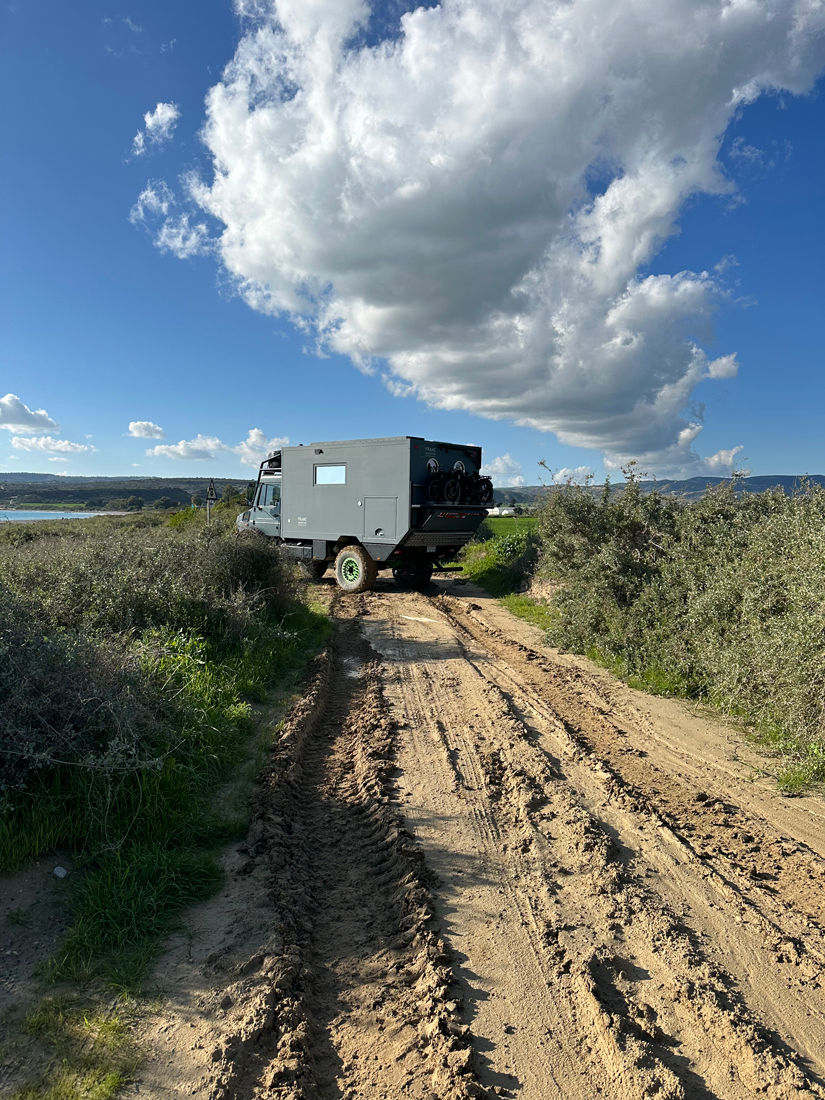
We now head for a kite school on Kyrenia Beach near Avdimou. Suddenly we're back on a single track road. Memories of last summer in Scotland come flooding back. A few hundred metres before our actual destination, however, the road, which has since become a dirt track, becomes so muddy and slippery that the rear end occasionally breaks loose. It's an extremely unpleasant feeling when you realise that your rear wheels suddenly want to overtake you. In fact, we are still riding with normal road pressure on our Michelin XZL tyres. We don't want to change this just because of some mud and prefer to turn around in the tightest of spaces and drive the couple of kilometres back onto the main road.
We are still on British soil and try our luck at Kourion Beach. Lots of stones, but nothing really special awaits us here. The feel-good factor is missing. Continue with the text. The road now winds its way up the cliffs towards Episkopi over a hundred metres in altitude. We are actually looking for the exit to Zapallo Beach, but it is closed to all vehicles, people and animals. Five huge menhirs make it impossible to drive through here, probably because of the risk of rockslides. But up here on the edge of a small turning area we find the spot that fulfils our strict selection criteria. A fantastic view over the cliffs from south-east to west. We check the ground carefully, including any watercourses in case of rain. We are less than fifteen metres from the abyss, but it feels safe here. Once again a room with a view, simply priceless!

above: 130 metres above Zapallo Beach we stand...
below: ...only 15 metres from the cliffs on safe ground

Our enthusiasm for Cyprus grows with each of these fantastic beaches and cliffs. So does the next one, the Aphrodite's Rock. Just under a kilometre after the rocks, which are heavily frequented by tourists, a small path leads steeply down to the beach. Just right for our Unimog and our obsession with solitude and seclusion. Those who circle the Aphrodite Rocks three times are said to be blessed with eternal love. Well, in today's surf, such an endeavour seems more likely to end in the eternal abysses of Neptune. We prefer to leave the task of circumnavigating to our drone and enjoy the cosy togetherness in front of our vehicle. The orientation of the sun here is unbeatable. Sunrise over Aphrodite, the sun over the sea all day and finally a romantic sunset along the beach to the west. The thoroughfare at the top of the cliff is inaudible thanks to the surf. To avoid any surprises, we choose a dry day to get back up to the road. We still don't know exactly how steep our vehicle can climb, but that is about to change soon.
above: The legendary rocks of Aphrodite
below: Making cooking fun
After a week of indescribably beautiful beaches along the south coast of Cyprus, today we arrive in Paphos, the tourist stronghold of the west. As usual, we use the day to replenish our supplies. To get our favourite organic fruit and vegetables, we are prepared to drive a few kilometres out of our way. We find Biolouc, a small but excellent organic food shop in the far north of the city, somewhere in the middle of nowhere. We wonder how it can survive here. In Chloraka, a small suburb of the city, we also find an admirable beekeeper with an extensive range of organic honey products. Brigitte is on cloud nine.
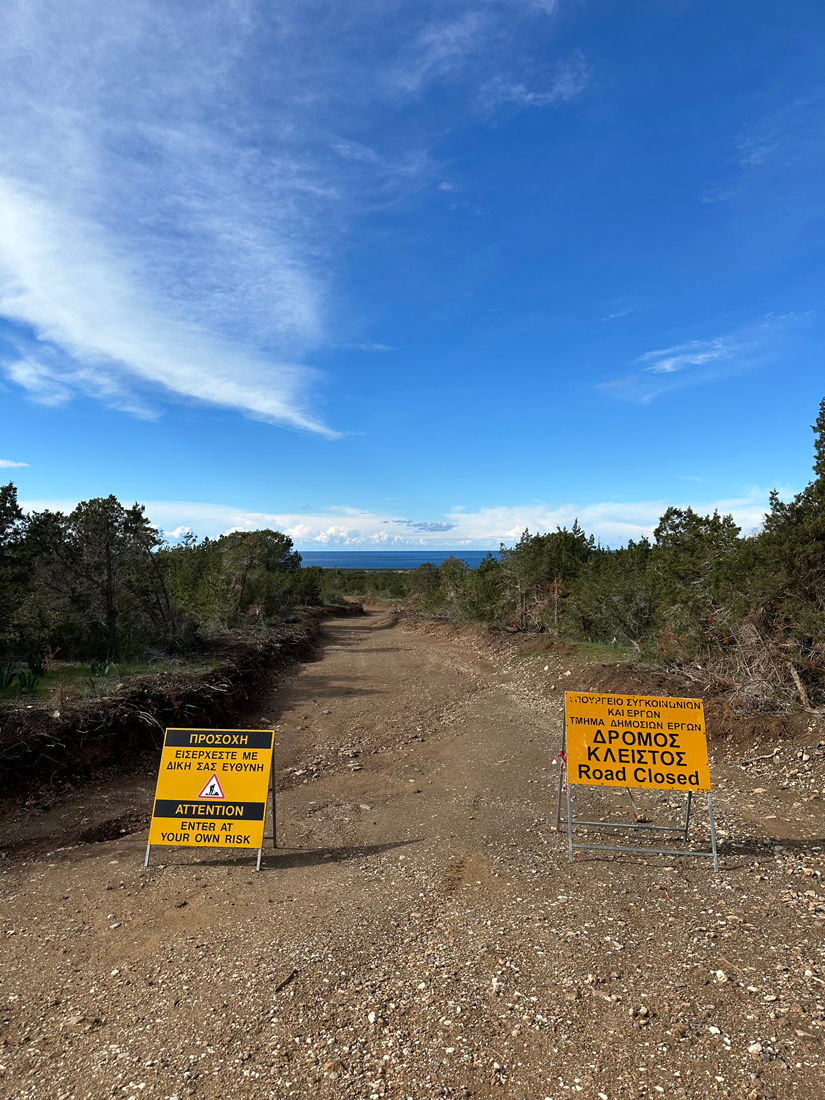
The onward journey northwards to the Akamas Peninsula is uncertain. We read in forums about road closures just before Lara Beach, which is actually our destination for the next night. The road is suddenly impassable, but at the moment there is still a signposted diversion. And so we continue. Again and again, our path branches off the ideal route, crossing one puddle after another and finally returning to the Lara Road. Puddles become small ponds and the natural road turns into soft soap. Despite this, or perhaps because of it, I have to keep reconnoitring the upcoming bends on foot. Up to and including Lara Beach, we are actually very disappointed. Perhaps we've just picked too wet a season. In any case, it makes no sense for us to spend the night at Lara Beach today. We drive a few hundred metres up the mountain and lo and behold, the puddles are gone and the landscape suddenly becomes beautiful. We get out to check the suitability of a potential place to spend the night and the first thing we smell is a spicy freshness. I wonder where that comes from. It looks like a well-tended garden here. Sea onions grow between the coral-like stones and the nodding wood sorrel shines like little suns in the lush greenery between ancient carob and olive trees. We like it here, we're staying here!
above: For once a pitch away from the sea, surrounded by pure nature
below: A short hike up the next hill lets us really immerse ourselves into Akamas
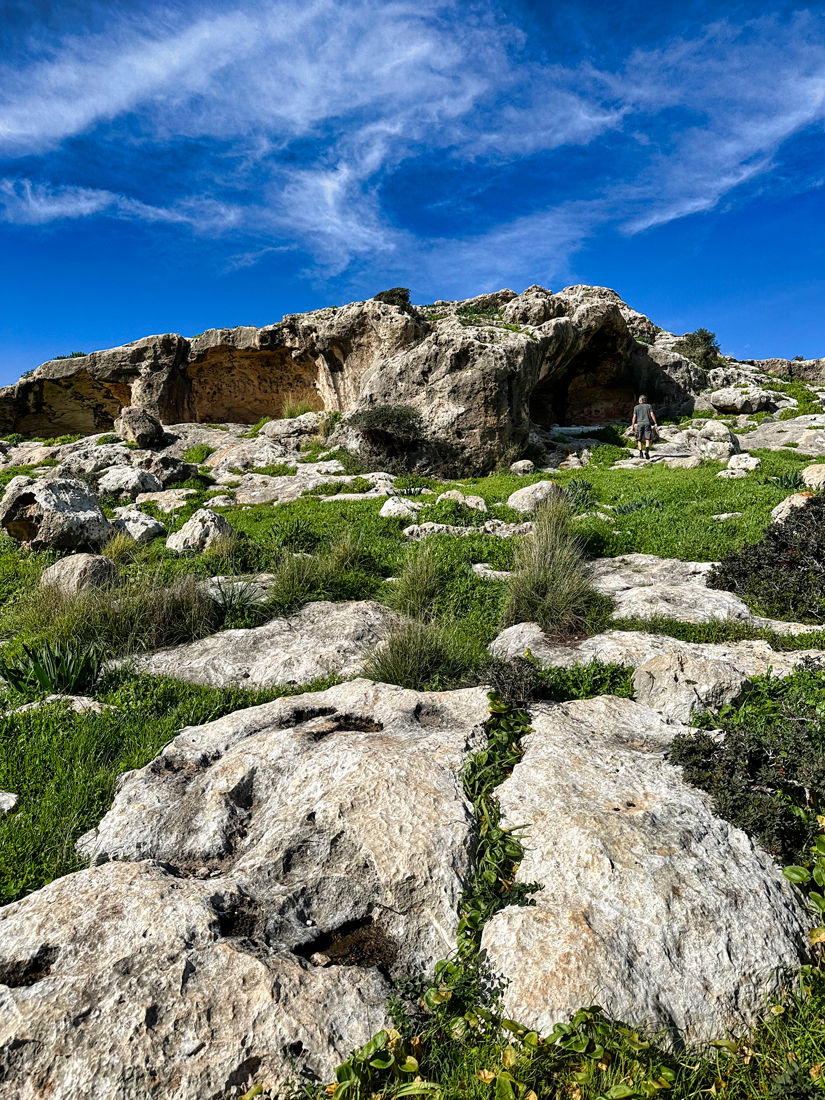
What we weren't really looking for in Paphos, we hope to find a few kilometres from here. Fresh mountain spring water. Our off-road GPS has ingeniously marked all the wells and springs, as well as thousands of other useful POIs (points of interest). First we pass the Zac's Hill Caves, which stimulate our fantasies about life here thousands of years ago. As long as there was enough drinking water around here, it was probably very liveable. The hills are inspiring, small pools of water in the porous rock interspersed with a colourful profusion of flowers and various man-high juniper bushes. Nature is beautiful! We ignore the occasional plastic bottles, aluminium cans or shooting cartridges lying around.
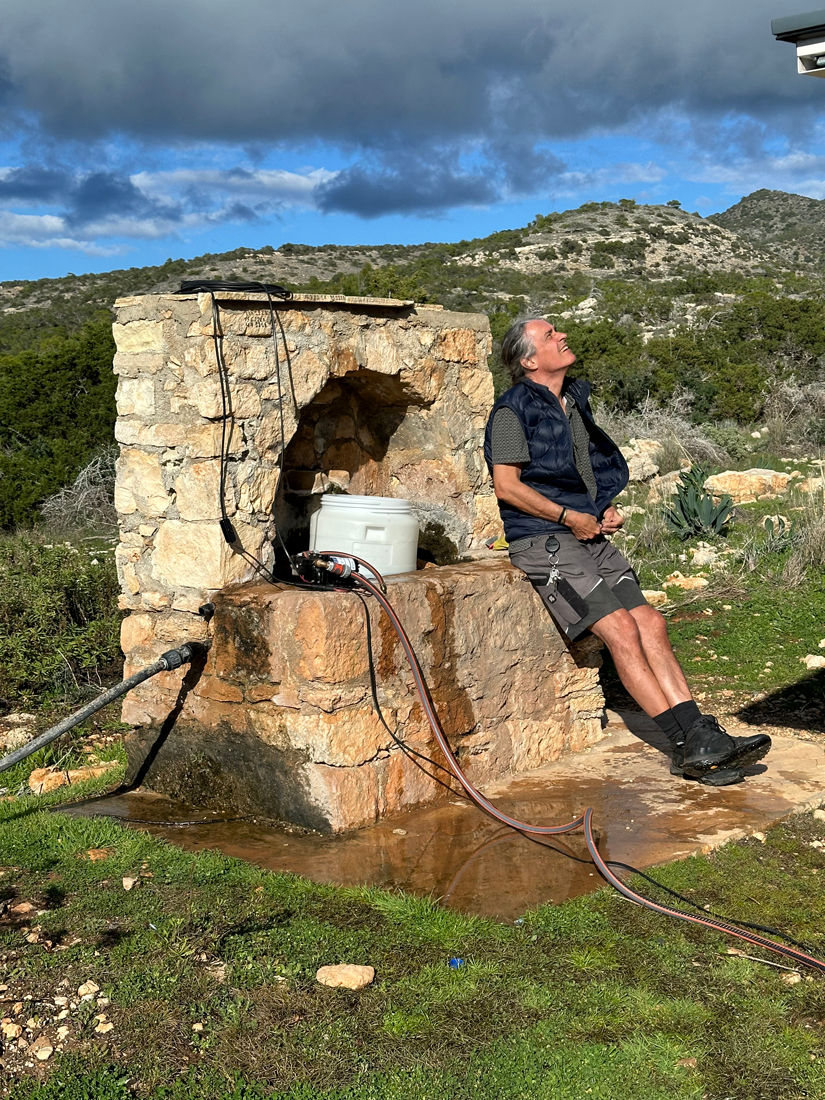
A few puddles further down the road, we finally stand in front of the fountain we had hoped for. The water is actually flowing, albeit sparsely, but it is flowing. Of course, the pressure is nowhere near enough to force it through our sophisticated water filter system. So, wide-necked barrel down from the roof and water pump straight out. Fortunately, we are also equipped for such cases. We place our 30 litre bucket in the well and wait patiently until it is reasonably full. Then the cool water is pumped into the FRAME at a decent pressure in just under a minute. We repeat the procedure every twelve minutes. After all, there is nothing you won't do for fresh mountain spring water.
We underestimated the amount of time we would need at the fountain. There is little time to find a pitch for the night. We take one of the next turn-offs down to the sea. The tracks are only just wide enough for us. Without a place to turn round, driving back will be rather difficult. For today, however, we just want to arrive and stand as straight as possible without having to use our levelling cushions. I manoeuvre the Unimog with one eye and enjoy the sunset over the sea with the other. Even though the sun sets every day, it's always great to watch and beautiful to behold.
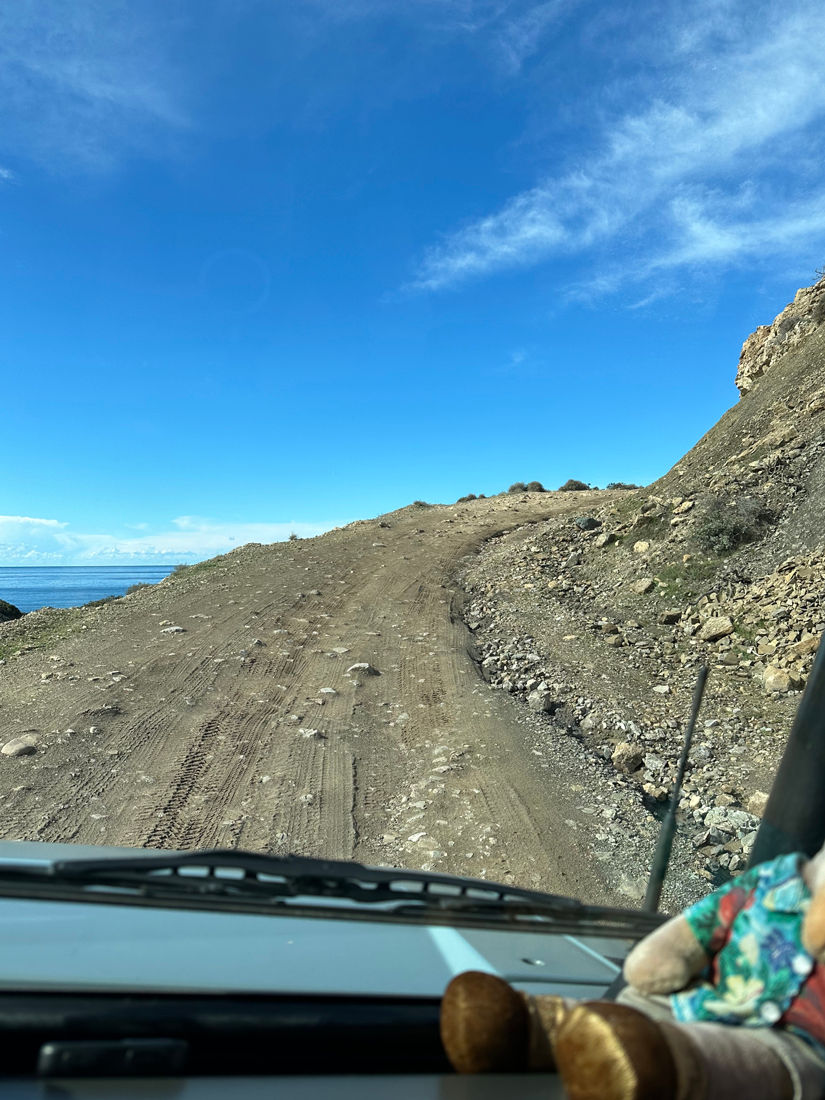
The following day should have been dedicated to the westernmost point of Cyprus. "Going beyond the limits" was our motto right from the start. This westernmost point fits the bill perfectly. The steadily increasing mud and the otherwise rather bare rocky landscape finally put us off this destination. If safe passage is not guaranteed or we don't really enjoy it, then it makes no sense for us to force through a set driving destination. My co-pilot already has an alternative challenge ready for us: Crossing the Akamas "mountain range" to get to the eastern side of the peninsula. With an elevation gain of just 200 metres, this sounds like an easy task and so we drive up the first climb without any worries. What comes next is the classic off-road dynamic.

The first difficulty is followed by the second, then the third and so on. After the tenth, you've progressed so far that it's no longer worth turning back. And why should we? Our FRAME masters all the challenges without any problems and I get used to constantly getting out, marching off, setting the line, walking back and continuing. We don't even cover five kilometres today, believe it or not, because we only walk twice as much as we drive. Finally, the underride guard is folded in for the descent. Now we are really in off-road modus. Only an additional reduction in tyre pressure would give us some more room for optimisation.
Light rain sets in. The challenge on the steep, rocky track gets even tougher. First of all, we stand and wait. The bare rock is now too slippery for us and eventually the road drops over 90 per cent in places, not to mention the numerous steps, which we master thanks to the high ground clearance. At some point, however, it becomes too much for my fair co-driver. Once again, we are just under a kilometre from the finishing line and it hurts to pull the ripcord here. Now all the way back? That can't be true!
above: Washed-out tracks quickly become critical in wet conditions
below: The Unimog is supposed to manage 100% (45°) gradients? Yes, it actually does!
But we won't be doing that today. In the meantime, it's raining cats and dogs, despite the fact that the weather forecast was almost never bad. Two hundred metres earlier, I saw a herd of goats coming up a narrow path from the bottom right and now I keep asking myself whether this path, although much narrower, could perhaps be a little less steep? Despite the mucky weather, I walk three kilometres down and three kilometres back up again. My conclusion: it's definitely doable. We let one night pass and with the first sunshine early in the morning, we have a little more courage to continue our journey. The Blue Lagoon comes within reach again with this goat path and indeed, our perseverance is rewarded. With a few additional scratches from bushes and trees, but otherwise without too much adrenalin and beads of sweat, we manage the descent to the sea. Battle tracks are simply part and parcel of an off-road vehicle, and in the meantime we've become very relaxed about it. Somewhat elevated with a view of the entire coast, we finally settle down on a quickly drying meadow.
above: We've made it! We are standing above the Blue Lagoon and feel like we are in paradise
below: Spending time by the sea and under the numerous olive and carob trees
It's already weekend again and the bird hunters are getting into position early in the morning. It's a paradox: this beautiful island has very few prohibition signs. This is actually astonishing when you consider the British history of Cyprus. The only bans we see over and over again are hunting bans. And nobody really seems to care about that here. The locals and tourists hunt birds and hares like mad. The fact that over two million birds are allegedly killed every year is one thing. But the millions of shell casings lying around in all colours and littering the countryside are probably just as saddening. The pollution caused by plastic bottles and beer cans is regrettable enough. Whenever we find space in our own rubbish bags, we fill them up with trash. In Cyprus, however, we could easily have filled a 100 litre bag with shell casings from illegal hunters in the first two weeks already ;-(

The turquoise waters of the Blue Lagoon are simply heavenly. For more of this, be sure to watch our videos on YouTube!

We enjoy the next few days at the incredibly turquoise blue bays of Blue Lagoon, Manolis and Amphitheatre Bay. All hell must break loose here in summer, no wonder. They all come here on foot, by quad bike or by boat from Polis or Latsi along the coast. Adventurous safari providers also like to drive the more laid-back tourists along these paths, which are signposted as "dangerous", in their off-road jeeps.
Next blog: 4.4 Up to the highest peak in the Troodos Mountains















































































wow cool!